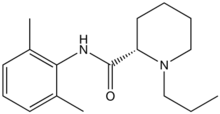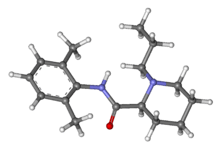Ropivacaine
 | |
 | |
| Clinical data | |
|---|---|
| AHFS/Drugs.com | Consumer Drug Information |
| Pregnancy category |
|
| Routes of administration | Parenteral |
| ATC code | N01BB09 (WHO) |
| Legal status | |
| Legal status |
|
| Pharmacokinetic data | |
| Bioavailability | 87%–98% (epidural) |
| Metabolism | Hepatic (CYP1A2-mediated) |
| Biological half-life | 1.6–6 hours (varies with administration route) |
| Excretion | Renal 86% |
| Identifiers | |
| |
| CAS Number |
84057-95-4 |
| PubChem (CID) | 175805 |
| IUPHAR/BPS | 7602 |
| DrugBank |
DB00296 |
| ChemSpider |
153165 |
| UNII |
7IO5LYA57N |
| KEGG |
D08490 |
| ChEBI |
CHEBI:8890 |
| ChEMBL |
CHEMBL1077896 |
| ECHA InfoCard | 100.128.244 |
| Chemical and physical data | |
| Formula | C17H26N2O |
| Molar mass | 274.4 g/mol |
| 3D model (Jmol) | Interactive image |
| |
| |
| (verify) | |
Ropivacaine (rINN) /roʊˈpɪvəkeɪn/ is a local anaesthetic drug belonging to the amino amide group. The name ropivacaine refers to both the racemate and the marketed S-enantiomer. Ropivacaine hydrochloride is commonly marketed by AstraZeneca under the trade name Naropin.
History
Ropivacaine was developed after bupivacaine was noted to be associated with cardiac arrest, particularly in pregnant women. Ropivacaine was found to have less cardiotoxicity than bupivacaine in animal models.
Clinical use
Indications
Ropivacaine is indicated for local anaesthesia including infiltration, nerve block, epidural and intrathecal anaesthesia in adults and children over 12 years. It is also indicated for peripheral nerve block and caudal epidural in children 1–12 years for surgical pain. It is also sometimes used for infiltration anaesthesia for surgical pain in children.
Ropivacaine is often coadministered with fentanyl for epidural analgesia, for example in pregnant women during labour.
Contraindications
Ropivacaine is contraindicated for intravenous regional anaesthesia (IVRA). However, new data suggested both ropivacaine (1.2-1.8 mg/kg in 40ml) and levobupivacaine (40 ml of 0.125% solution) be used, because they have less cardiovascular and central nervous system toxicity than racemic bupivacaine.[1]
Adverse effects
Adverse drug reactions (ADRs) are rare when it is administered correctly. Most ADRs relate to administration technique (resulting in systemic exposure) or pharmacological effects of anesthesia, however allergic reactions can rarely occur.
Systemic exposure to excessive quantities of ropivacaine mainly result in central nervous system (CNS) and cardiovascular effects – CNS effects usually occur at lower blood plasma concentrations and additional cardiovascular effects present at higher concentrations, though cardiovascular collapse may also occur with low concentrations. CNS effects may include CNS excitation (nervousness, tingling around the mouth, tinnitus, tremor, dizziness, blurred vision, seizures followed by depression (drowsiness, loss of consciousness), respiratory depression and apnea). Cardiovascular effects include hypotension, bradycardia, arrhythmias, and/or cardiac arrest – some of which may be due to hypoxemia secondary to respiratory depression.[2]
Treatment of overdose
As for bupivacaine, Celepid, a commonly available intravenous lipid emulsion, can be effective in treating severe cardiotoxicity secondary to local anaesthetic overdose in animal experiments[3] and in humans in a process called lipid rescue.[4][5][6]
References
- ↑ (Basic of Anesthesia, Robert Stoelting, page 289)
- ↑ Rossi S, editor. Australian Medicines Handbook 2006. Adelaide: Australian Medicines Handbook; 2006. ISBN 0-9757919-2-3
- ↑ Weinberg, G; Ripper, R; Feinstein, DL; Hoffman, W (2003). "Lipid emulsion infusion rescues dogs from bupivacaine-induced cardiac toxicity". Reg Anesth Pain Med. 28 (3): 198–202. doi:10.1053/rapm.2003.50041. PMID 12772136.
- ↑ Picard, J; Meek, T (2006). "Lipid emulsion to treat overdose of local anaesthetic: the gift of the glob". Anaesthesia. 61 (2): 107–9. doi:10.1111/j.1365-2044.2005.04494.x. PMID 16430560.
- ↑ Rosenblatt, MA; Abel, M; Fischer, GW; Itzkovich, CJ; Eisenkraft, JB (2006). "Successful Use of a 20% lipid emulsion to resuscitate a patient after a presumed bupivacaine-related cardiac arrest". Anesthesiology. 105 (1): 217–8. doi:10.1097/00000542-200607000-00033. PMID 16810015.
- ↑ Litz, RJ; Popp, M; Stehr, S N; Koch, T (2006). "Successful resuscitation of a patient with ropivacaine-induced asystole after axillary plexus block using lipid infusion". Anaesthesia. 61: 800–1. doi:10.1111/j.1365-2044.2006.04740.x. PMID 16867094.
External links
- European Society of Anaesthesiologists: Use of ropivacaine in clinical practice
- More on lipid rescue